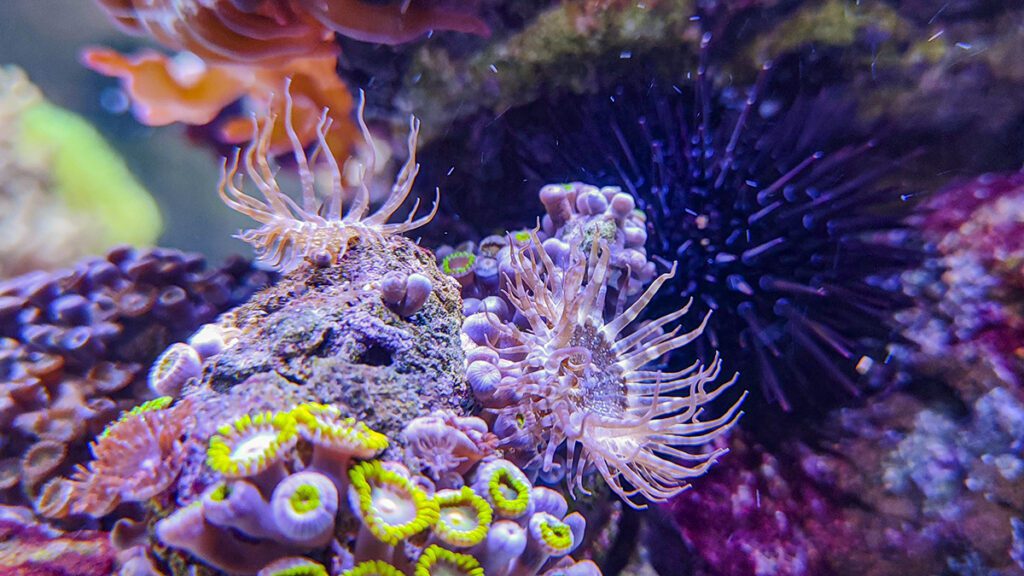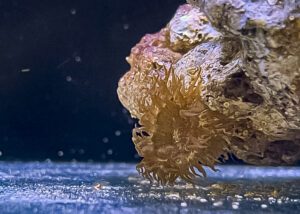What are Aiptasia?
Aiptasia are soft-bodied invertebrates that exhibit the ability to store significant amounts of water in their bodies. Also known as glass anemones, they are considered pests in marine aquariums. Because Aiptasia are small creatures (they can grow up to 5 – 7 cm), they can be difficult to spot in the tank at first.
Aiptasia are able to meet their energy needs by feeding on zooplankton and through photosynthesis carried out by their endosymbiotic microalgae (zooxanthellae). According to research, this symbiotic relationship can supply up to 95% of photosynthetically fixed carbon to the host, which may allow some Aiptasia species to survive without any external food for long periods of time.
Why should you remove Aiptasia?
You may be wondering why glass anemones are considered a pest. Here is why: the first reason is that Aiptasia have stinging cells, and the toxins released from these cells are strong enough to harm corals and fish in the aquarium.
The second reason is that Aiptasia reproduce rapidly (sexually and asexually), these sea anemones are capable of reproducing rapidly in reef aquaria, once there is good lighting and abundant nutrients, they will over-populate your tank and eventually outcompete other species.
They often reproduce by detaching part of a foot and thus creating a new anemone. Even one cell can be enough to create a new Aiptasia. It can take about 2 weeks for a new polyp to develop. Under laboratory conditions, just 1 Aiptasia has produced up to 5,000 clones of itself in a year!
To recognise Aiptasia, observe and look out for a light brown transparent polyp with long brown tentacles. The elongated, tapering tentacles extend from the mouth plate connected to the long body column down to the foot. They quickly withdraw their tentacles and hide in holes and crevices in the rocks when threatened.
There are many methods of controlling the presence of Aiptasia in the aquarium; these include control by natural predators, physical and chemical methods.
Dealing with it when you see the first signs is the easiest point at which you can solve the problem. Because if you think there are any easy ways to remove it overnight – you are wrong. Depending on the level of infestation, it can take weeks or even months to get rid of Aiptasia completely.
Ways of dealing with Aiptasia
Natural predators
There are quite a number of predators that are known to eliminate Aiptasia in coral reef aquaria. These include the following organisms:
Chelmon:
Chelmon rostratus – a beautifully coloured fish (it has yellow-orange vertical stripes with a black border. It has a false eye spot on the back of the dorsal fin, this is to deceive a predator. It has a long yet narrow snout, which allows it to hunt in crevices and hard-to-reach places for other fish.
Note: The problem is that it is a delicate fish for experienced keepers. It is a food specialist and will often not accept frozen or dry food. We also have no guarantee that every fish will eat Aptasia.
Acreichthys:
Acreichthys tomentosus – is said to be one of the best Aiptasia eaters. They just swim around and suck them up. However, in many cases we have to give these fish some time before they start eating Aiptasia. Another problem is that they can also nibble on soft corals and LPSs. So the cure may turn out to be worse than the disease.
Shrimps:
Lysmata wurdemanni is the first choice when it comes to choosing a shrimp that eats Aipstasia, this shrimp is small, with a translucent reddish body marked with red horizontal lines. The wundermani shrimp is a great addition to the tank aesthetically and is less likely to damage fish, corals and clams.
The shrimp Rhynchocinetes durbanensis can also eat Aiptasia anemones, but there are many reports of its low effectiveness against Aptasia, instead it is often heard that these shrimps have a taste for corals.
Some Hermit Crabs:
Dardanus Megistos are popular in saltwater tanks and are lesser known eaters of Aiptasia, but are seen feeding on its anemones. Particularly juveniles that simply eat whatever is available including Aiptasia.
Nevertheless, I would be very careful with Dardanus Megistos species, as they grow really big (up to 12 cm and more). When they are small, they will keep the tank really nice and clean. However, once they grow a bit bigger, their carnivorous nature will be a threat to all smaller fish and invertebrates.
Berghia snails:
Berghia stephanieae eat Aiptasia and only Aptasia, once they have dealt with these pests they will simply die of starvation. Therefore, once you have finished cleaning the tank, move them to another tank where they will have food in abundance. We can often see advertisements where aquarists give these snails away when they have finished their task in their tank.

Chemical method
The chemical method of controlling Aiptasia involves injecting these organisms with concentrated chemical solutions using a needle or syringe. Remember that any chemicals will affect the water parameters in the tank, so do not use too many. Don’t try to kill all the Aiptasia in one day, 5 to 10 a day will be more than enough.
Warning: corrosive chemicals are harmful to the human body, so you should always wear protective eye goggles and hand gloves as an essential precaution.
Calcium hydroxide (Kalkwasser):
An effective method of killing Aiptasia is to inject it with calcium hydroxide in a strong, concentrated solution.
The problem with this method is that the kill rate is low if the solution is not directly injected into them and if the solution is not strong enough to effectively kill Aiptasia. Another problem is that if you try to kill too many Aiptasia at once, it can disrupt the water chemistry and change the pH level in your aquarium due to adding too much calcium hydroxide at once.
Sodium hydroxide:
This chemical should be properly mixed to create a concentrated solution strong enough to kill these anemones on contact. Remember to wear protective clothing and gloves before handling this solution, as it can irritate and burn the skin.
Glue:
You may as well use epoxy or glue to seal the Aiptasia into the rock they live in, this is effective as long as there is no escape route.
Branded chemicals dedicated to combating Aptasia:
There are a number of chemicals manufactured by companies that are used to combat Aptasia. These are chemicals that are applied with a syringe to visible anemones. There are many agents on the market, opinions are divided on their effectiveness, it is probably a matter of application.
When using chemicals, remember to switch off the circulation and circulators for at least half an hour after application. These treatments should be done regularly in order to achieve the desired effect.
Laser
For some aquarists, the fight against Aptasia has entered a completely different level. Once all methods have failed, technology comes to the rescue. It is becoming increasingly common to hear about the use of lasers to control these pests. Concentrated beams of light burn the cells of these anemones, effectively annihilating them.
Many manufacturers use a UV band as a light beam, which is commonly used to sterilise surgical instruments, or food. This is supposed to further weaken the aptasia and help get rid of them even more effectively.
This treatment, depending on the design of the device, is carried out underwater or directly through the glass in the aquarium. However, regardless of which manufacturer you choose, it is important to remember to protect your eyes. Even a weak laser can permanently damage our eyesight.
How to avoid Aiptasia?
Buy reproduced corals from shops that take care to ensure that they do not have Aiptasia in their systems. They take all necessary steps to ensure that there are no pests, including Aiptasia, in their system. If you want to avoid this problem altogether, you will need to set up a quarantine tank. This is the only way to ensure that pests do not get into your tank.
Check your sump and refugium!
There are many people who complain that they cannot remove Aiptasia from their system. No matter what they do, this pest always comes back. Well, in many cases they simply forget about the sump and refugium. So, don’t forget about them either.
Aiptasia is a pest and its presence should not be underestimated. They can completely overrun a tank and will eventually harm the other inhabitants if you do not get rid of them.
Controlling this pest can prove difficult even for an experienced aquarist. Be aware that careless handling will end up in scattered fragments that turn into mature anemones and the problem will persist.
About the author

Marek Protasewicz
Reefkeeping has been my passion for over 10 years now. I love learning. The hobby has taught me many valuable lessons, patience being the best example.
Combining work and passion is my path. I run Crazy Coral, a marine aquarium shop, for a number of years. Building this business from the scratch I learnt from my own mistakes at a heavy cost.
Later I managed a project aimed at development of methods for quick growth of Corals in non-natural conditions. The project was carried out by Get Sales, Poland.
Presently, I am responsible for distribution strategy at Reef Factory, of which I am a
co-founder. The company produces smart devices for marine aquaristics.
The last projects I have been involved in are Social Reef and ReefPedia.




